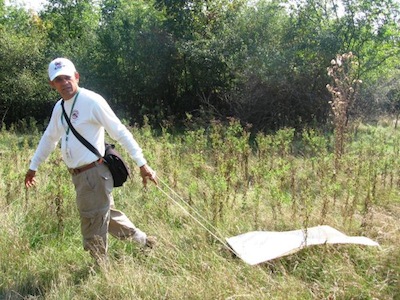Passive Tick Surveillance
Passive surveillance is when information is given to the Health Unit. It relies on tick submissions from doctors and the public to find out if blacklegged ticks are within Middlesex-London. If you have found a tick on a human, submit a photo of the tick to etick.ca or review How to Submit a Tick to the Health Unit. Tick submissions are identified in the Health Unit’s Strathroy laboratory.
Active Tick Surveillance
Active surveillance is when the Health Unit goes out to look for ticks, or asks for information on ticks. The Health Unit looks for ticks by carrying out tick dragging in the Spring and Fall months, when tick populations are most active. Tick dragging is where a piece of white cloth is pulled along the ground. The ticks that attach to the white cloth are then counted to give the Health Unit an idea of how many and which types of ticks are in the area. Multiple tick submissions from the same neighbourhood will also prompt the Health Unit to carry out tick dragging and monitor tick populations closely within that area.
If a blacklegged tick is submitted and/or identified from within Middlesex-London, active tick surveillance would include follow-up tick dragging in the area of concern.
Health Unit staff “dragging” for ticks
